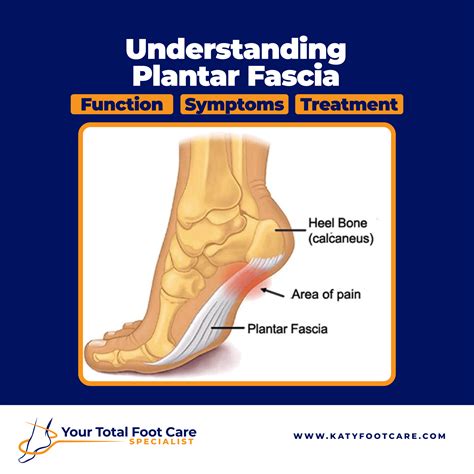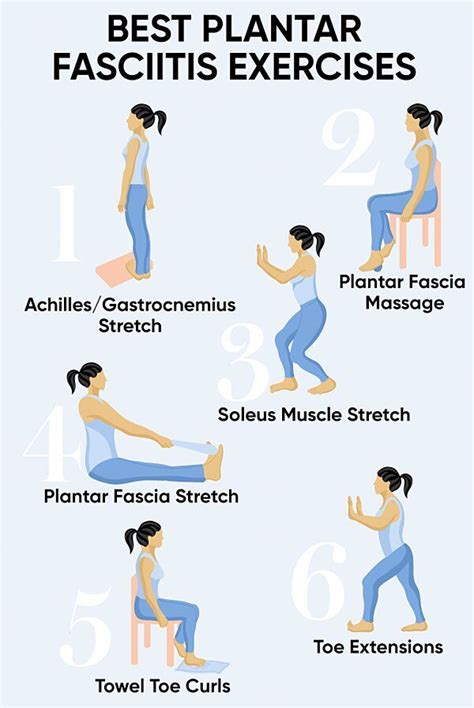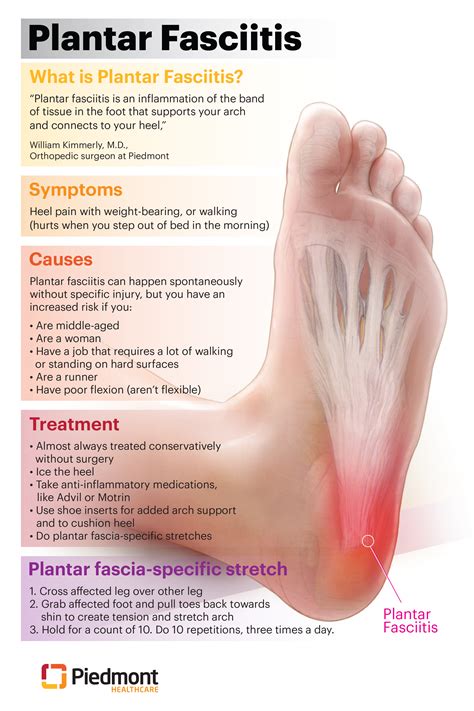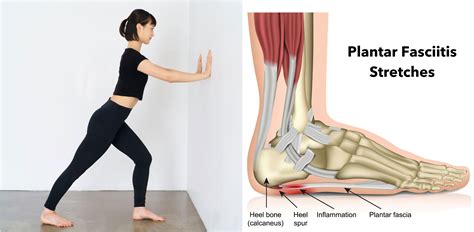Intro
Relieve plantar fasciitis pain with targeted stretches, including heel and toe stretches, calf raises, and foot rolls, to reduce inflammation and improve flexibility, promoting overall foot health and wellness.
Plantar fasciitis is a common condition that affects millions of people worldwide, causing pain and discomfort in the heel and bottom of the foot. The plantar fascia, a band of tissue that supports the arch of the foot, can become inflamed and irritated, leading to stiffness, swelling, and pain. While there are various treatment options available, stretches for plantar fasciitis relief are a simple and effective way to alleviate symptoms and promote healing. In this article, we will explore the importance of stretches for plantar fasciitis relief, the benefits of incorporating them into your daily routine, and provide a comprehensive guide on how to perform them.
The plantar fascia plays a crucial role in supporting the arch of the foot and facilitating movement. However, when it becomes inflamed or irritated, it can lead to plantar fasciitis. The condition is often caused by overuse, poor foot mechanics, or sudden changes in activity level. Stretches for plantar fasciitis relief can help to reduce tension in the plantar fascia, promote blood flow, and strengthen the surrounding muscles. By incorporating stretches into your daily routine, you can alleviate symptoms, improve flexibility, and reduce the risk of further injury.
Plantar fasciitis can have a significant impact on daily life, making it difficult to perform everyday activities such as walking, running, or standing. The pain and discomfort can be debilitating, affecting not only the foot but also the ankle, leg, and lower back. Stretches for plantar fasciitis relief can help to alleviate these symptoms, improving overall mobility and reducing the risk of chronic pain. By taking a proactive approach to managing plantar fasciitis, you can reduce the risk of further injury, promote healing, and improve your overall quality of life.
Understanding Plantar Fasciitis

Causes and Risk Factors
Plantar fasciitis is often caused by a combination of factors, including poor foot mechanics, overuse, and sudden changes in activity level. Other risk factors include age, obesity, and certain medical conditions such as diabetes and arthritis. By understanding these risk factors, you can take steps to reduce your risk of developing plantar fasciitis and promote overall foot health.Benefits of Stretches for Plantar Fasciitis Relief

Improved Flexibility
Stretches for plantar fasciitis relief can help to improve flexibility in the foot and ankle, reducing stiffness and promoting mobility. By improving flexibility, you can reduce the risk of further injury and promote overall foot health. Improved flexibility can also help to alleviate symptoms, reducing pain and discomfort in the heel and bottom of the foot.Simple Stretches for Plantar Fasciitis Relief

- Toe stretches: Stand on the edge of a stair or curb with your heels hanging off the edge. Slowly lower your heels down until you feel a stretch in the back of your leg. Hold for 15-30 seconds and repeat 2-3 times.
- Calf stretches: Stand facing a wall with one hand on the wall for balance. Step one foot back about a foot and a half, keeping your heel on the ground. Slowly bend your front knee, keeping your back leg straight, until you feel a stretch in your calf. Hold for 15-30 seconds and repeat 2-3 times on each side.
- Achilles tendon stretches: Stand with your feet shoulder-width apart. Step forward with one foot and lower your body down until you feel a stretch in the back of your leg. Hold for 15-30 seconds and repeat 2-3 times on each side.
Advanced Stretches for Plantar Fasciitis Relief
For those who are looking for more advanced stretches, there are several options available. These stretches can help to target specific areas of the foot and ankle, promoting healing and reducing the risk of further injury. Some of the most effective advanced stretches for plantar fasciitis relief include:- Foot rolls: Sit on the floor with your affected leg crossed over your other leg. Place a tennis ball or foam roller under your foot and slowly roll it back and forth, applying pressure to the affected area. Repeat for 2-3 minutes, 2-3 times a day.
- Ankle circles: Sit on the floor with your affected leg straight out in front of you. Lift your foot off the ground and draw circles with your ankle, starting from small circles and gradually increasing in size. Repeat for 2-3 minutes, 2-3 times a day.
Preventing Plantar Fasciitis

- Wearing supportive shoes: Wearing shoes that provide adequate support and cushioning can help to reduce the risk of plantar fasciitis.
- Stretching regularly: Regular stretching can help to improve flexibility and reduce the risk of injury.
- Maintaining a healthy weight: Excess weight can put additional stress on the feet, increasing the risk of plantar fasciitis.
Tips for Preventing Plantar Fasciitis
In addition to wearing supportive shoes, stretching regularly, and maintaining a healthy weight, there are several other tips that can help to prevent plantar fasciitis. These include:- Avoiding overuse: Avoiding activities that involve repetitive stress on the feet, such as running or jumping, can help to reduce the risk of plantar fasciitis.
- Using orthotics: Using orthotics, such as arch supports or shoe inserts, can help to reduce stress on the feet and prevent plantar fasciitis.
- Getting regular foot massages: Regular foot massages can help to improve circulation, reduce tension, and promote overall foot health.
Conclusion and Next Steps

We hope this article has provided you with a comprehensive guide to stretches for plantar fasciitis relief. If you have any questions or comments, please don't hesitate to share them with us. We would love to hear about your experiences with plantar fasciitis and how you have managed to alleviate symptoms. Share this article with your friends and family who may be suffering from plantar fasciitis, and let's work together to promote overall foot health and wellness.
What is plantar fasciitis?
+Plantar fasciitis is a common condition that affects the plantar fascia, a band of tissue that supports the arch of the foot. It can cause pain and discomfort in the heel and bottom of the foot, and can be caused by overuse, poor foot mechanics, or sudden changes in activity level.
How can I prevent plantar fasciitis?
+Preventing plantar fasciitis involves wearing supportive shoes, stretching regularly, and maintaining a healthy weight. Avoiding overuse, using orthotics, and getting regular foot massages can also help to reduce the risk of plantar fasciitis.
What are the best stretches for plantar fasciitis relief?
+Some of the most effective stretches for plantar fasciitis relief include toe stretches, calf stretches, and Achilles tendon stretches. Foot rolls and ankle circles can also help to target specific areas of the foot and promote healing.
How often should I stretch for plantar fasciitis relief?
+It is recommended to stretch 2-3 times a day, holding each stretch for 15-30 seconds. Remember to always consult with a healthcare professional before starting any new exercise or stretch routine, especially if you have a pre-existing medical condition or concern.
Can I use ice or heat to relieve plantar fasciitis symptoms?
+Yes, ice or heat can be used to relieve plantar fasciitis symptoms. Ice can help to reduce inflammation and pain, while heat can help to relax the muscles and promote healing. However, it is always best to consult with a healthcare professional before using ice or heat therapy.
